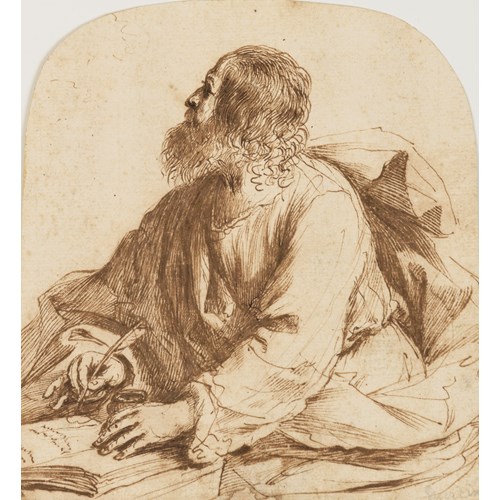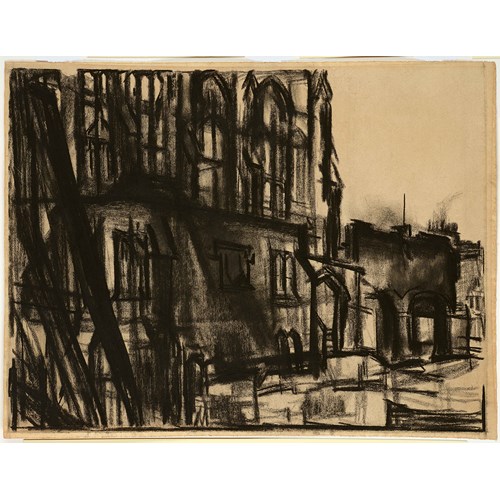Marketplace
Sheet of Figure Studies
This lively sheet of sketches - which was once folded into four, perhaps to be sent as a letter - is typical of Paolo Veronese’s working method in its seemingly random arrangement of figures and compositional groupings. As James Byam Shaw has written of such drawings, ‘Veronese’s brilliant method of first sketching with the pen and then adding patches of grey and brown wash, seemingly careless but in fact applied with great skill and judgement, to clarify the forms or groups, linking them, on a large sheet of paper, into an elegant pattern, chain-like, serpentine or circular, [is] often a thing of abstract beauty in itself…sometimes Paolo shows the same flair in combining on one sheet sketches for different subjects.’
The two sketches of the Virgin and Child at the upper right of the recto, as well as the three studies of a reclining male figure with his right arm raised at the bottom of the sheet, may be tentatively related to Veronese’s altarpiece of The Virgin Appearing to Saint Luke, painted for the church of San Luca in Venice in c.1581. At the left of the present sheet, delineated by a part of a framing line, is a composition depicting a preaching(?) figure standing above a crowd of onlookers; the same preaching figure is studied again at the right edge of the sheet. Among stylistically comparable drawings is a Sheet of Studies for a Visitation, Saint Nicholas in Glory, Faith and Charity, formerly in the Franz Koenigs collection at the Boijmans-van Beuningen Museum in Rotterdam.
There are extensive inscriptions at the upper centre and right of the sheet which, though difficult to decipher with any accuracy, seem to refer to a costing of various projects. On both sides of the sheet are further inscriptions in a different 16th century hand, some of which appear to be superimposed over autograph texts; the inscriptions on the verso appear to be a list of some sort, with several items crossed out. Neither text appears to be in Veronese’s handwriting, however, as it is known from surviving autograph letters. A similar list with crossed-out items, also not in the hand of the artist, is found on the verso of a drawing by Veronese in the Louvre depicting Count Giuseppe da Porto with his son, which is a preparatory study for a painted portrait of c.1553-1554 in the Palazzo Pitti in Florence. The practice of drawing on the back of a list written by someone else is not unusual for the artist, who also often drew on the backs of letters and other documents. As Richard Cocke has pointed out, ‘Veronese often seems to have been short of paper. He used someone else’s notes for the Study of Count Giuseppe da Porto and his son Adriano, letters to him [for other sheets of sketches]…[as well as] a draft of a letter he never sent…and a page of his own accounts…’
The two sketches of the Virgin and Child at the upper right of the recto, as well as the three studies of a reclining male figure with his right arm raised at the bottom of the sheet, may be tentatively related to Veronese’s altarpiece of The Virgin Appearing to Saint Luke, painted for the church of San Luca in Venice in c.1581. At the left of the present sheet, delineated by a part of a framing line, is a composition depicting a preaching(?) figure standing above a crowd of onlookers; the same preaching figure is studied again at the right edge of the sheet. Among stylistically comparable drawings is a Sheet of Studies for a Visitation, Saint Nicholas in Glory, Faith and Charity, formerly in the Franz Koenigs collection at the Boijmans-van Beuningen Museum in Rotterdam.
There are extensive inscriptions at the upper centre and right of the sheet which, though difficult to decipher with any accuracy, seem to refer to a costing of various projects. On both sides of the sheet are further inscriptions in a different 16th century hand, some of which appear to be superimposed over autograph texts; the inscriptions on the verso appear to be a list of some sort, with several items crossed out. Neither text appears to be in Veronese’s handwriting, however, as it is known from surviving autograph letters. A similar list with crossed-out items, also not in the hand of the artist, is found on the verso of a drawing by Veronese in the Louvre depicting Count Giuseppe da Porto with his son, which is a preparatory study for a painted portrait of c.1553-1554 in the Palazzo Pitti in Florence. The practice of drawing on the back of a list written by someone else is not unusual for the artist, who also often drew on the backs of letters and other documents. As Richard Cocke has pointed out, ‘Veronese often seems to have been short of paper. He used someone else’s notes for the Study of Count Giuseppe da Porto and his son Adriano, letters to him [for other sheets of sketches]…[as well as] a draft of a letter he never sent…and a page of his own accounts…’
Provenance: Anonymous sale, Paris, Hôtel Drouot, 18 March 2005, lot 10 (as Attributed to Veronese)
Private collection, New York.
More artworks from the Gallery






_T638451686580251969.jpg?width=500&height=500&mode=pad&scale=both&qlt=90&format=jpg)

